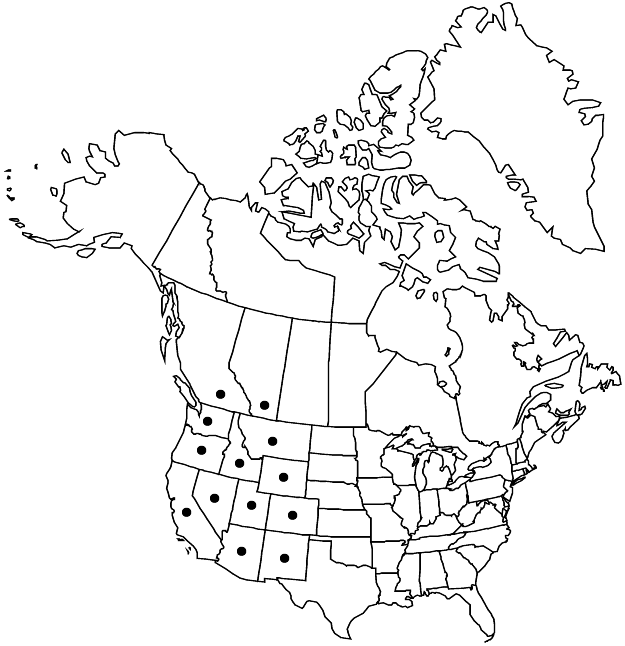Eriogonum ovalifolium
J. Acad. Nat. Sci. Philadelphia 7: 50, plate 8, fig. 1. 1834.
Herbs, forming pulvinate to cespitose maps, usually scapose, 0.2–3 × 0.5–5 dm, floccose to tomentose or lanate. Stems decumbent to spreading, with persistent leaf bases, up to 1/5 height of plant; caudex stems matted to spreading; aerial flowering stems scapelike, spreading to erect, infrequently decumbent to ascending, slender, solid, not fistulose, 0.03–4 dm, floccose to tomentose or lanate or nearly glabrous. Leaves basal, 1 per node; petiole not twisted or curled, 0.1–10 cm, mostly tomentose; blade oblanceolate to elliptic or spatulate to rounded, 0.2–6 × (0.1–)0.2–1.5 cm, lanate to tomentose or floccose, sometimes less so adaxially, margins plane, occasionally brownish. Inflorescences capitate or rarely umbellate, 0.7–5(–7) × 1.5–5 cm; bracts 3, scalelike, linear to triangular, 0.8–4 mm. Peduncles absent. Involucres 1 per node or (2–)3–15 per cluster, turbinate to turbinate-campanulate, (2–)3.5–5(–8) × 2–4 mm, tomentose to floccose; teeth 5, erect, 0.1–1 mm. Flowers (2.5–)3–6(–7) mm; perianth yellow or white to cream, rose, red, or purple, glabrous; tepals connate proximally, dimorphic, those of outer whorl usually oval to orbiculate, 2–4 × 2–4 mm, those of inner whorl oblanceolate to elliptic, 3–7 × 0.8–1.5 mm; stamens mostly included, 1–3 mm; filaments pilose proximally. Achenes light brown to brown, 2–3 mm, glabrous.
Distribution

Alta., B.C., Ariz., Calif., Colo., Idaho, Mont., N.Mex., Nev., Oreg., Utah, Wash., Wyo.
Discussion
Varieties 11 (11 in the flora).
Eriogonum ovalifolium is a highly diverse and widespread complex of generally distinct but sometimes intergrading varieties. Several varieties are in cultivation and make worthy additions, especially to the rock garden. The dimorphic nature of the tepals is obvious only in fully mature flowers. In some populations of the more depauperate varieties, such as var. nivale and var. depressum, the tepals may not be as distinctly dimorphic. Nonetheless, the overall aspect of the species is unmistakable.
There are several reports of traditional use of Eriogonum ovalifolium by Native Americans. P. Train et al. (1941) indicated that a decoction of the roots is used in Nevada for colds. R. V. Chamberlin (1911) reported that the Gosiute Indians in southwestern Utah used it in a poultice or wash to treat venereal diseases.
Members of the species are food plants for Bauer’s dotted-blue butterfly (Euphilotes baueri).
Selected References
None.
Lower Taxa
Key
| 1 | Leaf blades 0.2-1.2(-2) cm; scapes usually 0.3-5(-9) cm, rarely longer; involucres usually 2-4.5 (rarely 5-8) mm | > 2 |
| 1 | Leaf blades usually 1-6 cm, occasionally shorter; scapes (1-)5-30(-40) cm; involucres (3.5-)4-6.5(-8) mm | > 8 |
| 2 | Perianths yellow; c Nevada and ec California | Eriogonum ovalifolium var. caelestinum |
| 2 | Perianths white, sometimes rose, purple, or red; widespread | > 3 |
| 3 | Leaf margins brownish | > 4 |
| 3 | Leaf margins not brownish or, if so, plants of high elevation, central Sierra Nevada | > 5 |
| 4 | Leaf blades densely lanate, margins brownish | Eriogonum ovalifolium var. eximium |
| 4 | Leaf blades tomentose, margins not brownish | Eriogonum ovalifolium var. williamsiae |
| 5 | Involucres 5-8 mm | > 6 |
| 5 | Involucres 3-4.5 mm | > 7 |
| 6 | Leaf blades white-lanate; San Bernardino Mountains, s California | Eriogonum ovalifolium var. vineum |
| 6 | Leaf blades tomentose to floccose; s Sierra Nevada, California | Eriogonum ovalifolium var. monarchense |
| 7 | Leaf blades greenish and thinly tomentose at least adaxially, usually elliptic, infrequently oblong to spatulate; scapes often suberect to decumbent, usually thinly floccose; Rocky Mountains of Alberta, Idaho, Montana, and Wyoming, desert ranges of ne Nevada and e Oregon | Eriogonum ovalifolium var. depressum |
| 7 | Leaves densely lanate to white-tomentose on both surfaces or only slightly less so adaxially, not at all greenish, usually round; scapes usually erect, lanate or tomentose; Sierra-Cascade cordillera, desert ranges of Great Basin | Eriogonum ovalifolium var. nivale |
| 8 | Scapes usually 1-5(-7.5) cm; leaf margins brownish; rare, wc Nevada, ec California | > 9 |
| 8 | Scapes usually (4-)7-30(-40) cm, rarely shorter; leaf margins only rarely brownish; widespread | > 10 |
| 9 | Leaf blades densely lanate, brownish margins | Eriogonum ovalifolium var. eximium |
| 9 | Leaf blades white-tomentose, margins not brownish | Eriogonum ovalifolium var. williamsiae |
| 10 | Inflorescences umbellate, branches 1-3 cm; c Idaho and Montana | Eriogonum ovalifolium var. pansum |
| 10 | Inflorescences capitate, branches absent; widespread | > 11 |
| 11 | Flowers 5-7 mm; involucres 5-7 mm; s California | Eriogonum ovalifolium var. vineum |
| 11 | Flowers 4-5 mm; involucres 4-6.5 mm; widespread | > 12 |
| 12 | Perianths yellow | Eriogonum ovalifolium var. ovalifolium |
| 12 | Perianths white to rose or purple. | > 13 |
| 13 | Leaf blades spatulate, oblong, or obovate to oval; scapes (4-)5-20 cm; widespread | Eriogonum ovalifolium var. purpureum |
| 13 | Leaf blades oblanceolate to narrowly elliptic; scapes (15-)20-30(-40) cm; Montana and Wyoming | Eriogonum ovalifolium var. ochroleucum |